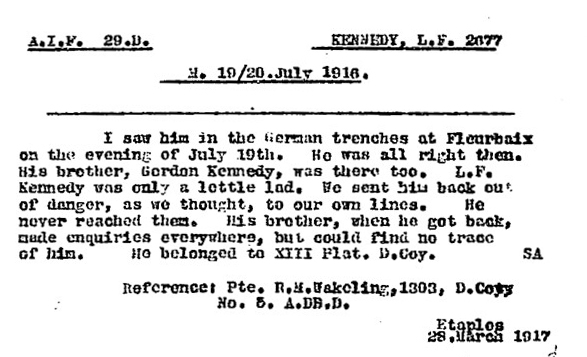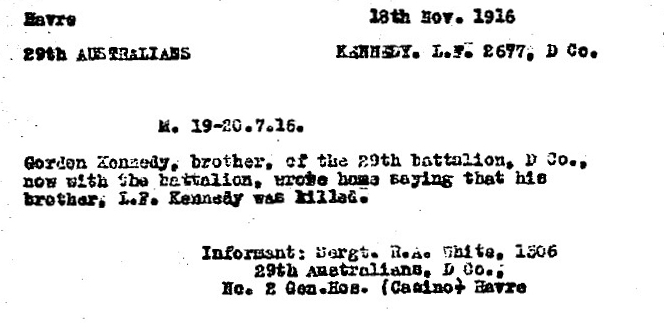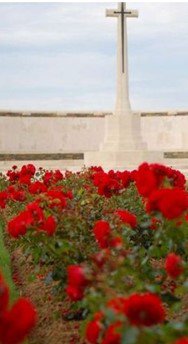Leslie Frederick KENNEDY
Eyes gray, Hair light, Complexion fair
Leslie Frederick Kennedy
Can you help us identify Leslie?
Leslie was killed in Action at Fromelles. As part of the 29th Battalion he was positioned near where the Germans collected soldiers who were later buried at Pheasant Wood. There is a chance he might be identified, but we need help. We are still searching for suitable family DNA donors.
In 2008 a mass grave was found at Fromelles, a grave the Germans dug for 250 (Australian) bodies they recovered after the battle. As of 2024, DNA matching from relatives has enabled the identification of 180 of these soldiers.
If you know anything of contacts for Leslie here in Australia, please contact the Fromelles Association.
See the DNA box at the end of the story for what we do know about his family.
Early Life
Leslie Frederick Kennedy was born in Chiltern, Victoria in July 1896. He was the sixth of John “Jack” and Annie (nee Topen) Kennedy’s eleven children. Leslie’s father worked on the railways and their children were born in different parts of Victoria.
Leslie attended the State School in Chilwell, Geelong Victoria, then the Geelong State School and he was also trained in Music.

After he finished his schooling, his background in music led him to work as a salesman for Sutton’s Music, a major store for musical instruments – pianos, etc.

Off to War
As was typical of the time, Leslie served in the Citizens’ Forces Junior Cadets. When he turned 18, he was exempted from serving in the Citizens’ Military Forces because of his height, 5’ 2” – and as his mother had written, “not appearing likely that he would reach standard height (5’6”)”
Source: AWM Roll of Honour Circular, Kennedy Leslie Frederick.
The AIF minimum height of 5’ 6” was reduced to 5’ 2” in July 1915. When the War broke out, the 18 year old Leslie tried to enlist (twice), but was not accepted until 24 January, 1916 – measured at 5’ 2 ¼”. He had the consent of both of his parents. His older brother Gordon was 5’ 5 ¾“ and enlisted in July 1915. Gordon was assigned to the 29th Battalion, D Company (No. 1154). When Leslie was accepted he requested to be with his brother.
The boys’ younger brother Wallace, 5’ 2”, enlisted in May 1918 when he was old enough. He remained in Australia. A cousin of the boys, Thomas Kennedy (6291), served in 14th Battalion.
With the Western Front ramping up, Leslie sailed from Melbourne on 14 March 1916 after only six weeks of military training. The HMAT A68 Anchises arrived in Suez, Egypt on 15 April. Leslie finally joined his brother on 25 May at the Ferry Post camp on the Nile River.
After further month of training, the brothers left Egypt for the Western Front aboard the Tunisian, arriving in Marseilles on 23 June. They were put on trains to Hazebrouck and Steenbeque and were finally encamped in Morbecque by the 26th, about 30 km from Fleurbaix. The Aussies were well received by the French.
In a letter home, James Lang (858), 29th Battalion from Glengarry, Victoria, wrote:
“The French people lined the streets to see us, and gave us a great welcome. Lots of poor women and young girls started crying. No doubt the poor things were thinking of their own dear ones who had gone to the front.”
Gas masks were now included in their training for the possible use of “lachrymatory shells” – tear gas. Training was tough and rugged. One day included a march of 16 miles carrying a 75 lb kit, which only the youngest and fittest could complete.
On 9 July the 59th were moved to Erquingham, just outside of Fleurbaix and on the 10th they got their first experience in the trenches, with the “men all in good spirits”.
Source: AWM4 23/46/12 29th Infantry Battalion July 1916 page 3
They were back at their billets in Fleurbaix four days later. A gas alarm was sounded on the 15th, but there was no effect on the troops in Fleurbaix.
Fromelles

The 29th’s role in the upcoming battle was to be a ‘fourth’ battalion on the left flank of the attack. With the 30th they were to provide support for the attacking 31st and 32nd Battalions by digging trenches, carrying supplies/ammunition and to be called in as reserves if needed for the fighting. The original attack was planned for the 17th, but bad weather caused it to be postponed.
On 19 July the 29th were in the rear trenches, ready for the attack. The 32nd’s charge over the parapet began at 5.53 PM and the 31st’s at 5.58 PM. There were machine guns emplacements to their left and directly ahead at Delrangre Farm and there was heavy artillery fire in No-Man’s-Land. The initial assaults were successful and by 6.30 PM the Aussies were in control of the German’s 1st line system, which was described as:
“practically a ditch with from 1 to 2 feet of mud and slush at the bottom.”
By 8.00 PM, Leslie and Gordon’s D Company and A Company and began to carry bombs and supplies to the front trenches. The Australians’ left flank had also come under heavy bombardment with high explosives and shrapnel. Return bombardment support was provided and the 32nd was told - “the trenches were to be held at all costs”.
Source: AWM4 23/49/12, 32nd Battalion War Diaries, July 1916, page 12
At 10.00 PM, additional support was being requested and Lesley’s D Company and C Company joined in. Unfortunately, they found that a number of the grenades they were carrying had no fuses. The Germans counter attacked and at 2.00 AM and by this time the brothers were fully engaged in the fighting. B and C Companies continued to carry supplies and provide cover for soldiers who were retiring from the battle.
However, “After a struggle in No-Man’s Land, the Germans were content to stop at their own trench.”
Source: AWM4 23/46/12, 29th Battalion War Diaries, July 1916, page 7

At 2 O’clock the enemy were counter attacking….
Fighting continued through the night. At 4.00 AM the Germans began an attack from the Australian’s left flank, bombing and advancing into the communications trench. Given the Australian advances that had been made earlier, portions of the rearward trench had been left almost empty, which then enabled the Germans to be in a position to surround the advanced soldiers.

With the Australian attack having been halted, they became exposed in a salient jutting into the German lines and were quickly enfiladed by German machine guns:
“In the end, they basically had to fight their way back to their own lines, 'run for it', or be killed, wounded or captured.”
In the morning the battle was over. The 29th were left to hold the front line and, even though a cease fire was not in effect, they were busily bringing back a large number of wounded. The nature of this battle was summed up by Private Jim Cleworth (784) from the 29th:
"The novelty of being a soldier wore off in about five seconds, it was like a bloody butcher's shop".
For a battalion supposed to be in a support role, the initial figures of the impact of the battle on the 29th was 17 soldiers died, 161 were wounded and 68 were missing. To get some perspective of the battle, when Charles Bean, Australia’s official war historian, attended the battlefield two and half years later, he observed a large amount of bones, torn uniforms and Australian kit still on the battlefield.
Ultimately, 63 soldiers of the 29th Battalion were killed in action or died of wounds from the battle and 37 of them were unable to be identified.
Leslie’s Fate
Gordon survived the battle, but Leslie was among the missing.

Ralph Wakeling survived the War.
There are other reports that say Leslie was shot through the head and that the trench he may have been in was destroyed by shell fire, but all were clear that Leslie had been killed in the battle.
As above, Gordon did all he could to find out about his brother, but then he had the unenviable task of sending the sad news home.

While the family knew Leslie had been killed in action, for more than a year no further news was provided by the Army.
In an August 1917 letter to the Army, Leslie’s father John recognised the difficulty of working through a verification processes – POW, hospital checks, interviews, etc., but he rightfully ‘complained’ about the lack of official news and of not being able to get something from Leslie’s belongings to allow closure for the family.

A 23 August Court of Inquiry finally declared Leslie as having been killed in action at, but none of personal items were able to be returned to his family.
Lesley was clearly missed.
Gordon luckily “came through (the War) unscathed” – his mother Annie’s comments. You can read his soldier story here. Source: AWM Roll of Honour Circular, Kennedy Leslie Frederick
Lesley was awarded the British War Medal, the Victory Medal, a Memorial Plaque and a Memorial Scroll.
He is commemorated at:
- V.C. Corner Australian Cemetery, Fromelles,
- The East Geelong War Memorial
- and the Russell St Baptist Church Honor Roll.
Could Leslie Still be Found?
While he was officially “missing”, his Army file does have a very brief, undated annotation about him being buried at Fromelles, along with some very general map coordinates which are in the area of the Pheasant Wood German burial pit that was found in 2008.

It is unknown how this information came to be associated with Leslie, but of the eight known soldiers with this map reference on their file, six have been identified from the Pheasant Wood grave - Thomas William Francis, David Frederick Livingston, James Hugh Ross, Gordon Thomas Smith, Ernest Frank Wilkin and George Robert Barnatt.
Only James Gordon Charles Downie and Leslie Frederick Kennedy have not been located to date.
In total, 22 of the 37 originally unidentified soldiers from the 29th Battalion have been found to be at the Pheasant Wood burial site by DNA testing. Leslie could be one of the yet unidentified soldiers in the burial pit. Family DNA donors are needed to find out if Leslie could be one of these unidentified soldiers.
Family connections are sought for the following soldier
| Soldier | Leslie Frederick Kennedy Name (1896-1916) |
| Parents | John Kennedy (1862-1929) b Geelong, VIC, d Geelong VIC and Annie Topen (1864-1931) d Geelong, VIC |
| Siblings | John Robert (1884-1943) b Williamstown, VIC, d Geelong, VIC | ||
| Maud Amelia (1887-1963) b Williamstown, VIC, d Geelong, VIC | |||
| Annie Cicily (1889-1967) b Williamstown, VIC, d Wentworthville, NSW | |||
| Helene Mary Ann (1892-1954) b Williamstown, VIC, d Geelong, VIC | |||
| Gordon William (1894-1973) b Williamstown, VIC d Geelong, VIC, m Thelma Phillis Maxted | |||
| Albert James (1898-1955) d Geelong, VIC | |||
| Wallace (1900-1956) d Parkville, VIC | |||
| Edward Royal (1902-1966) d Geelong, VIC | |||
| Nelson Victor (1905-1973) d Geelong, VIC | |||
| Reginald Septimus (1908-1979) d Geelong, VIC |
| Grandparents | |||
| Paternal | Unknown | ||
| Maternal | Robert Topen, Sarah Weddell |
The Fromelles Association would love to hear from you

Contacts
(Contact: carla@fromelles.info or geoffrey@fromelles.info).
(Contact: army.uwc@defence.gov.au or phone 1800 019 090).
Donations
If you are able, please contribute to the upkeep of this resource.
(Contact: bill@fromelles.info ).



